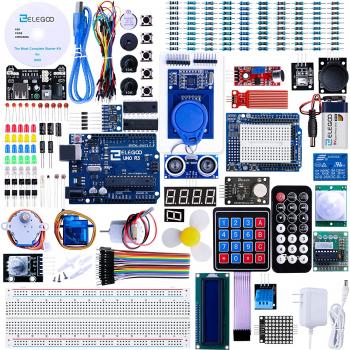
Junior Engineers: Building with Circuits and C++

- School:
- Immokalee Middle
- Subject:
- Engineering
- Teacher:
- Anthony Fernando
- Students Impacted:
- 20
- Grade:
- 6-8
- Date:
- July 25, 2022
Investor
Thank you to the following investor for funding this grant.
Nancy Garfien - $2,000.00
Original Grant Overview
Goal
The goal of this project is to provide the students with an afterschool activity that challenges the best of students and encourages students to learn how technology is built, manipulated, and ultimately how to create complex pieces of interactive technology on their own. A secondary goal is to demystify how basic objects work such as speedometers in cars and fuel gauges in boats.
What will be done with my students
Throughout the course of last year, I have been learning how to program using this kit. To date I have mastered most of the components in the kit and have created lessons that will take beginning students with no knowledge of either engineering concepts, circuits, or programming and give them real world practical skills that will allow them to build their own creations. The purpose of this grant is to build a compelling and challenging afterschool program at IMS that teaches children real world skills and how to create complex technological based objects utilizing engineering techniques and programmable circuits. We will accomplish this goal by purchasing the Elegoo circuit kit from Amazon. We will then build their skills in sections teaching both programming and circuit building at the same time. Each section will have a teacher guided activity and it will be followed by having the students work in groups of two (each with their own kit) to accomplish an expansion of that goal to demonstrate their grasp of the knowledge. At the end of each unit the student will be tasked with the creation of an object that functions on their stated goals and parameters. Funding this project will provide benefits not just this year but well into the future as all of these kits can be repeatedly reused. We will also ask for more kits then we will have seats so that we never have to fear breakage. Additionally there will be a 1 to 1 student to equipment ratio.
Benefits to my students
There are several benefits to my students in this section. The first benefit is that they will be challenged significantly. The second benefit is that they will learn real world skills and the applications of what they learn will have direct parallels to how objects work in real life. For this project we will use the C++ programming language. This is a benefit because they can utilize what they learn with me in both their high school experience and it will provide them with foundational knowledge for college programming level classes (colleges commonly use C#).
Budget Narrative
Thirty kits will be purchased from Amazon. This will support a class size of 20 children in the afterschool activity. Ten supplemental kits will be held in reserve in case of breakage or loss. I am not assuming due to resistance in recent years that we can use the tax free status of the school to purchase these kits. The cost of each kit is currently as of 7/25/2022, $59.99. The additional $201.00 is primarily for tax; however, shipping may also prove to be a factor in the future. Currently shipping is also free using Amazon Prime. If the kits were ordered today we would likely be returning money at the conclusion of the year.
Items
| # | Item | Cost |
|---|---|---|
| 1 | ELEGOO UNO R3 Project Most Complete Starter Kit (30) | $1,799.00 |
| 2 | Shipping and Tax | $201.00 |
| Total: | $2,000.00 |



Share
Please share this page to help in fulfilling this grant.
Email to a Friend